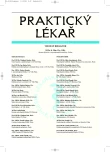Pancreatic cancer II.
Authors:
I. Holcátová 1; P. Souček 2; D. Vrána 3; A. Slámová 1; M. Schejbalová 1; R. Strnad 3; M. Brabec 2; M. Ryska 4
Authors‘ workplace:
Univerzita Karlova, 1. lékařská fakulta, Ústav hygieny a epidemiologie, Praha
Přednosta: prof. MUDr. Vladimír Bencko, DrSc.
1; Odborná skupina biotransformací, Státní zdravotní ústav, Praha
Ředitel: MUDr. Milan Bořek.
2; Onkologické centrum Baťovy nemocnice Zlín
Primář: MUDr. Milan Kohoutek.
3; Chirurgická klinika 2. lékařské fakulty
a Ústřední vojenské nemocnice Praha
Přednosta: prof. MUDr. Miroslav Ryska, CSc.
4
Published in:
Prakt. Lék. 2008; 88(8): 462-465
Category:
Of different specialties
Overview
Pancreatic carcinoma is one of the tumours with the worst prognosis. Even today its risk factors are not clear. Since the Czech Republic is one of the countries with the highest occurrence of this disorder in the world, a case–control study of this tumour was initiated by the International Agency for Research on Cancer, originally only in Czech Republic, with possible enlargement to other centres. The epidemiological part of the study gave no valid explanation for the relatively high occurrence of pancreatic tumours in Central Europe. First genetic analyses have produced interesting results, but a larger set of samples is necessary to confirm them.
Key words:
pancreas, carcinoma, risk factors, genetic analysis
Sources
1. Beger, H.G., Rau B., Gansauge, F. et al. Treatment of pancreatic cancer: challenge of the facts. World J. Surg. 2003, 27, p. 1075-1084.
2. Berrington de González, A., Spencer, E.A., Bueno-de-Mesquita, H.B. et al. Anthropometry, physical activity, and the risk of pancreatic cancer in the European prospective investigation into cancer and nutrition. Cancer Epidemiol. Biomarkers Prev. 2006, 15, 5, p. 879-885.
3. Ekbom, A., Hunter, D.: Pancreatic cancer. In: Adami, H.O., Hunter, D., Trichopoulos D.(eds.): Textbook of Cancer Epidemiology. Oxford Press 2002, p. 233-247.
4. Ferlay, J., Bray, F., Pisani, P., Parkin, D.M. GLOBOCAN 2002: cancer incidence, mortality and prevalence worldwide. IARC CancerBase No. 5, version 2.0. Lyon: IARCPress, 2004.
5. Holcátová, I., Slámová, A. Nádory slinivky břišní I. Potenciální rizikové faktory. Prakt. lék. 2006, 86, 1, s. 4-7.
6. Ryska, M., Strnad, R., Bělina, F. a kol. Radikální resekce u nemocných s karcinomem hlavy pankreatu. Retrospektivní analýza přežívání u souboru 307 nemocných. Rozhl. chir., 2007, 86, 8, s. 432-439.
7. Svačina, Š., Matoulek, M., Svobodová, Š. a kol. Nádory trávicího traktu a diabetes mellitus. Vnitř. lék., 50, 2004, č. 5, s. 386-391.
8. Zavoral, M. a kol. Karcinom pankreatu. Galen 2005.
Labels
General practitioner for children and adolescents General practitioner for adultsArticle was published in
General Practitioner

2008 Issue 8
Most read in this issue
- Chronic damage of the triangular fibrocartilage complex
- Acute facial palsy – a comparison of clinical and laboratory parameters in patients with Borrelia and idiopathic aetiology
- Stenosis of the left subclavian artery as a cause of angina pectoris progression after CABG: coronary-subclavian steal syndrome
- Acute exacerbation of chronic obstructive pulmonary disease as seen by the intensivist
